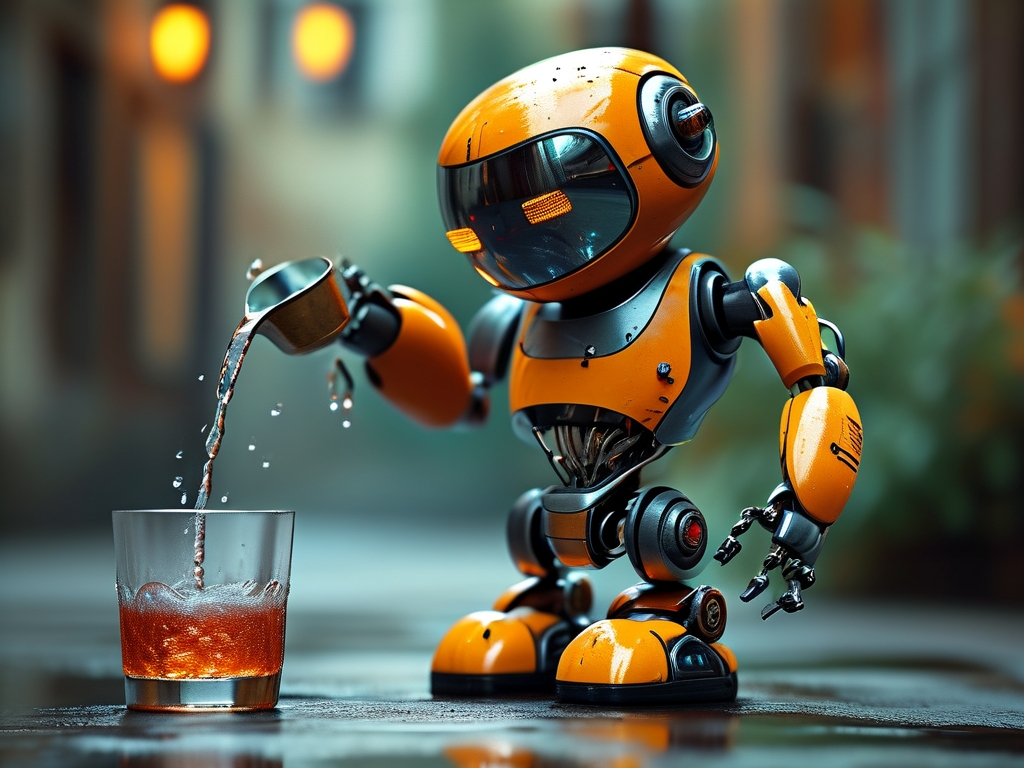The ability of robots to perform delicate tasks like pouring water has long been a benchmark for evaluating their dexterity and situational awareness. Robotic water-pouring technology combines advanced hardware design, sensor integration, and intelligent algorithms to achieve precision in dynamic environments. This article explores the technical foundations, implementation challenges, and potential applications of this emerging field.

1. Core Components of Robotic Water-Pouring Systems
A robotic system capable of pouring water relies on three critical elements:
- Mechanical Actuators: Multi-axis robotic arms with flexible joints mimic human wrist movements. For instance, collaborative robots (cobots) like UR5 or Franka Emika use torque-controlled motors to adjust grip strength and tilt angles.
- Sensory Feedback: Depth cameras (e.g., Intel RealSense) and force-torque sensors detect liquid levels, container shapes, and pouring dynamics. Lidar may supplement vision in low-light conditions.
- Control Algorithms: Machine learning models, particularly reinforcement learning, enable real-time adjustments. For example, NVIDIA's Isaac Sim trains robots in virtual environments to handle variable viscosities and prevent spills.
2. Technical Challenges in Fluid Manipulation
Pouring liquids introduces unique complexities:
- Fluid Dynamics: Unpredictable sloshing effects require predictive modeling. Researchers at MIT have used computational fluid dynamics (CFD) simulations to anticipate liquid behavior during abrupt motions.
- Container Variability: Robots must adapt to diverse containers (glass, plastic, uneven rims). A 2023 study by Toyota Research Institute demonstrated a vision-based system that maps container geometry in under 0.5 seconds.
- Environmental Uncertainty: External disturbances, like table vibrations, demand robust error correction. Hybrid control systems combining PID controllers with neural networks show promise here.
3. Breakthroughs in Adaptive Learning
Recent advancements leverage AI to overcome traditional limitations:
- Imitation Learning: By observing human demonstrations, robots acquire nuanced pouring techniques. OpenAI's Dactyl project achieved 98% success in transferring human-like fluid control to robotic hands.
- Tactile Sensing: SynTouch's BioTac sensors provide haptic feedback, allowing robots to "feel" liquid flow rates. This is critical for handling carbonated beverages or hot liquids.
- Edge Computing: On-device processing reduces latency. Qualcomm's RB5 platform enables sub-10ms response times, essential for preventing overflow.
4. Applications Beyond Basic Utility
While household robots like Samsung's Bot Chef showcase consumer applications, the implications extend further:
- Healthcare: Assistive robots can safely pour medications for patients with motor impairments.
- Industrial Automation: Precision pouring of chemicals in labs minimizes waste and exposure risks.
- Disaster Response: Drones equipped with pouring mechanisms could deliver water in inaccessible areas.
5. Ethical and Safety Considerations
As robots interact more closely with humans, safety protocols become paramount. Dual-layer fail-safes-such as pressure-sensitive grippers that halt operation upon collision-are being standardized. Additionally, energy-efficient designs (e.g., Tesla's Optimus sub-actuated joints) reduce risks of mechanical overexertion.
6. Future Directions
The next decade may see:
- Quantum-Enhanced Sensors: Improved fluid tracking via quantum dot imaging.
- Bio-Hybrid Systems: Integration of soft robotics inspired by natural organisms, like octopus tentacles.
- Swarm Robotics: Coordinated teams of micro-robots handling large-scale liquid transfer tasks.
In , robotic water-pouring technology epitomizes the convergence of mechanical engineering, AI, and material science. As systems grow more adaptive and energy-efficient, they will transition from lab curiosities to indispensable tools across industries-ushering in an era where machines handle even the most delicate tasks with human-like finesse.









